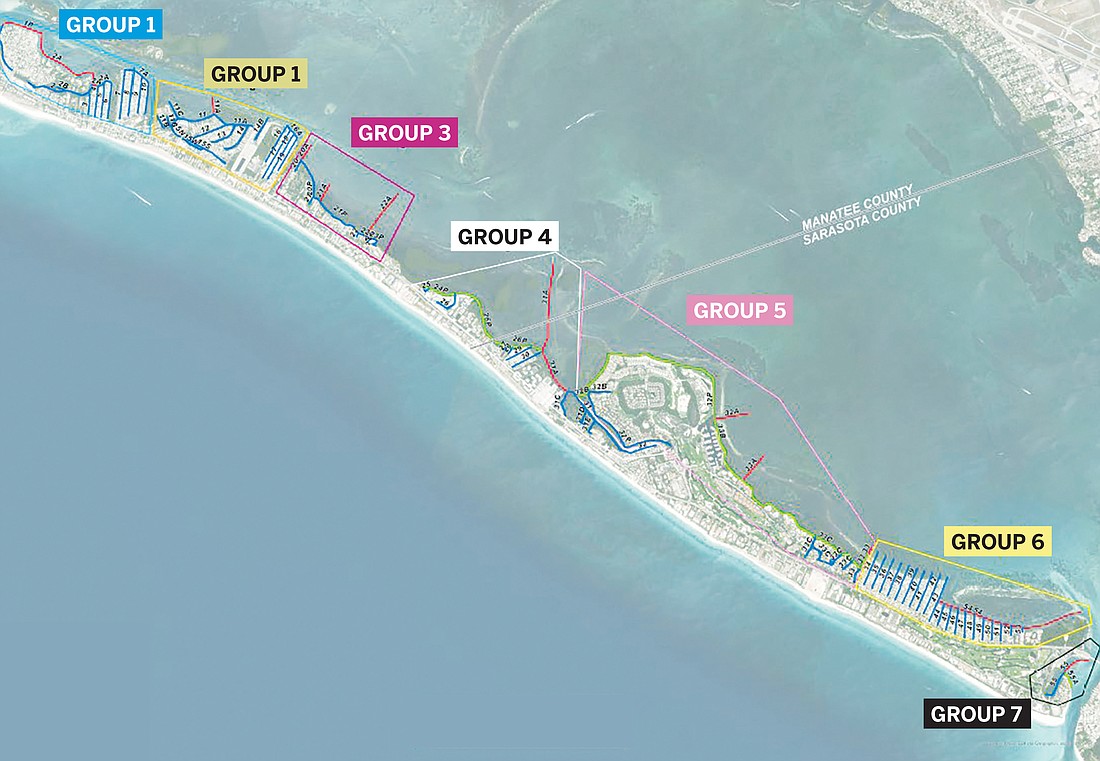- July 26, 2024
-
-
Loading

Loading

The latest presentation of Longboat Key’s canal maintenance program was an attempt to explain an elaborate cost apportionment method, but it left commissioners with more questions than answers.
Public Works Program Manager and Assistant Director Charlie Mopps led the presentation on Nov. 6 alongside Taylor Engineering, Inc. and Anser Advisory, LLC.
The intent of the program is to support future maintenance of Longboat's 81 canals to improve navigability within the canals.
The discussion was meant to explain how funds will be collected, dividing the island into seven groups and three classifications of canals.
But after about two hours of presentation, no consensus was reached and commissioners voted to push the matter to a meeting on Dec. 11. Further delays could put it behind schedule to be included on the 2024 tax roll.
The Nov. 6 presentation began with an overview from Taylor Engineering about how the island was split into groups, and what kind of engineering and surveys will be necessary before starting the $16.8 million project.
The $16.8 million will be spread across five years once the program is adopted, so all that money won’t need to be shelled out at once. Each of the groups will also be bid on separately.
That money is needed for engineering, permitting and dredging, according to the firms. Additional costs include finding dedicated staffing, studies and implementation.
And that's just what's needed to get the canals back to "normal," before the maintenance program begins.
“When you build a home, it costs a lot. When you maintain a house, it doesn’t,” Mopps said.
The last time Longboat Key underwent a major canal dredging project was in 2003, when only 30 of the 81 canals were dredged.
Some data was collected in 2016, but Taylor Engineering will need to conduct a new engineering survey before dredging this time.
Terence Cake from Taylor Engineering said this process includes bathymetric surveys, natural resource surveying, design, permitting, construction and long-term program development.
Based on direction from commissioners in March, Taylor Engineering began work with Anser Advisory to develop a program and funding methodology.
According to Cake, the island was split into seven different groups based on a variety of criteria including location, construction logistics, location of homeowners groups and staff input.
From there, the canals were identified as being either an access channel, arterial channel or local canal. Access channels are of general benefit, arterial are cost-share benefit and local are direct benefit.
The benefit relates to who is paying for the canals and how.
General benefit canals are paid for by millage, infrastructure sales surtax and grants. Cost-share benefit channels are canals that touch both private and public property. The cost for those will be split between the millage and the special assessment.
Local canals are those only adjacent to personal property, which will be paid for by the special assessment.
Total costs for all general benefit canals are estimated to be $1,221,975 a year over the five-year span, at a millage rate of 0.1524.
Local benefit canals were identified as being a benefit to only those residents who use them. The methodology for who pays is where some commissioners raised concerns and expressed confusion.
Anser Advisory representative Sandi Neubarth explained that many different ideas were conceived before using water access units to delegate costs.
Water access units are defined as access to waterways, such as boat ramps, docks and slips.
Properties on the local benefit canals will pay per water access unit. Therefore, if a single-family home is on a local canal, then it would receive the cost of one water access unit.
But, for example, a condominium complex that has five boat docks would see the cost of five water access units. If those docks are shared among everyone in the complex, the cost would be distributed equally.
These access units would be reassessed periodically — hence the need for dedicated staffing — because, as commissioners commented, those ramps sometimes change hands or homeowners associations' rules may change.
Taylor Engineering and Anser Advisory weren’t able to make it through the entire presentation before commissioners hit the brakes.
Common comments among commissioners were about needing to understand the methodology more clearly, and taking more time on the presentation. Some suggested the need for a case study at the next go-around.
“Quite honestly, if we cannot explain it to the public, and the staff can’t explain it in a simple form, this is going to be a disaster,” Commissioner-at-Large BJ Bishop said. “If it is not clear, simple and direct, (Town Manager Howard Tipton) can have 50 community meetings and they’re not going to go much better than what’s going on here.”
Tipton understood that no resolution would be reached like the team initially hoped.
“Based on the conversation today, we’re not moving forward. There's no consensus today,” he said.
But he also stressed that commissioners keep in mind the tight deadline that would need to be followed.
The town was supposed to adopt a resolution of intent on Dec. 4, but now with the discussion being pushed to Dec. 11, that won’t be possible. But the resolution could potentially be moved on at the next meeting.
A public hearing will be held in June 2024 before the final assessment is adopted. That would put the town on track to make it in time for the November 2024 tax bill.